While I’m nominally focusing this series of posts on paper circuitry, I’m actually looking to put together a resource for myself and others for any kind of electronics project. To that end, there are some ideas below that have nothing to do with affixing a circuit to paper, but that might still be an interesting or fun alternative.
- 1. Tins
- 2. Repurposed Plastic Enclosure
- 3. 3D Printed Enclosure
- 4. Off the Shelf Plastic Enclosures
- 5. Lamination
- 6. Encapsulation
Tins
Altoids and other tins are cute, small, and easy to source containers for projects. However, since they’re metal be sure to take extra care to wrap your electronics (or the inside of the tin) so that parts aren’t accidentally grounded against the tin. When I put a project in a MintDuino tin I used the paper cardstock from the packaging to insulate the project board.
Anything from paper to plastic should work fine. Cutting holes in the tin required a little more trial and error – since punching holes and using tin snips caused sharp edges. I solved these problems by wrapping the sharp edges in electrical tape – further adding insulation.
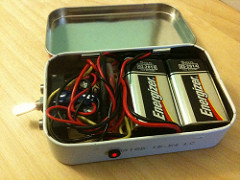
Repurposed Plastic Enclosure
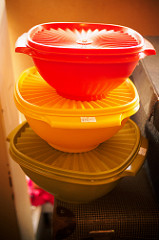
Plastic is probably a superior choice for an electronics project enclosure. As with tins, they come in a variety of shapes/sizes/colors, are cheap-to-free, and sturdy. Unlike tins, they don’t require any special insulation to work.
Besides rescuing containers from the recycle bin, don’t forget to check out your local dollar store. I picked up a particularly nice looking piece of tupperware with a big red screw top lid from the dollar store for a project and couldn’t be happier with it. If you do go to the dollar store, keep your eyes out for more than empty containers. Since everything in the store is a dollar, you can always dump the unused contents of a useful container.
If you do use/reuse a plastic container for a project, I would strongly suggest going very, very, slowly when drilling holes. Seriously, go as slow as you can manage to run the drill because rigid plastic has a tendency to crack under stress. Ideally, drill a small hole, then work your way up with larger bits. If you’ve got the equipment, you may want to consider actually melting holes instead.
3D Printed Enclosure
This is probably my favorite way to encapsulate a project. If you have access to a 3D printer and enjoy 3D design, you can have a cheap bespoke project container.
Off the Shelf Plastic Enclosures
I remember Radio Shack carrying a dizzying array of plastic enclosures when I was a kid. However, these days, I can’t think of a single reason to get an off-the-shelf project enclosure when there are just so many repurpose and dollar store options. I’m really only mentioning this option for the sake of completeness.
Lamination
I’ve really only tried one “lamination” project/experiment so far with very mixed results. However, I feel like this is a promising avenue for exploration and experimentation. These ideas allow for a project being sandwiched under or in between one or more layers of plastic. This could make a small and thin project more durable, while still leaving the parts visible for inspection and teaching. I also like the idea of potentially using additional with extra information printed on them which could be laid over the circuits for additional context and annotation.1
DIY Adhesive Lamination with Tape or Contact Paper
A much cheaper DIY alternative to off-the-shelf adhesive lamination sheets would be to use clear packing tape or contact/shelf paper. Both are inexpensive and durable options, but would need to be cut to size. I actually use the packing tape method to copy and consolidate cards for my minimalistic wallet.
Heat Lamination

I love the idea of designing a project, affixing it to a sheet of clear plastic like an overhead transparency, and then laminating it with a standard heat laminator. As the offspring of two elementary school teachers, I had ready access to a laminator as a kid and have some fond memories of (mis)using these machines. These days desktop sized laminators and the plastic heat lamination films are quite inexpensive and good for lots of different applications besides small electronics projects. My favorite laminator electronics use, ever, is easily this amazing modular solar panel project from rcpederson.
DIY Heat Lamination with Plastic Bags

This is an idea I’m really really looking forward to trying. Several years ago at a Benicia Mini Maker Faire I was introduced to the idea of fusing plastic bags together using a household clothes iron. The Makers showing this method let people cut scraps out of thin grocery and shopping bags, layer them between sheets of wax paper, and then fuse them together using an iron. They were using this process to create large colorful sheets of very durable plastic that could be cut and sewn like cloth.
While writing this post it occurred to me that this same method could be applied to paper circuitry, to embed a project within sheets of plastic. There are some interesting parallels to the process of using an iron to fuse aluminum foil to the toner on a laser printed page, described above. Additionally, by layering a project between sheets of plastic one might be able to dispense with some soldering since the fused sheets of plastic might be able to hold parts in direct physical contact with one another.
My Lamination Fail
The project I tried involved using 8B soft graphite art pencil traces and HVAC aluminum tape contact pads on copier paper, “laminated” in place with inexpensive clear packing tape. I believe my experiment didn’t quite work out because the packing tape may have pulled up some of the pencil traces, causing a break in the circuits. If you try to mix pencil graphite and packing tape, just be on the lookout for this possible issue.
There are several self-adhesive lamination plastic sheets available. Basically, there are two sheets of plastic, each with a sticky coating, which sandwich over your desired material. These come in various sizes from business card up to full 8-1/2″ x 11″ sheets.
These tend to be much more expensive than the heat lamination options, but require no additional materials. However, this is a decent option if your project cannot be subjected heat or pressure.
Encapsulation
Silicone Mold Material
As far as I know silicone rubber mold material comes in either a two-part liquid or two-part putty-like format. You mix the liquids in proportion, pour around desired object, cut apart and you get your mold. The putty kind is considerably less messy, but also much more expensive. You mix two balls of putty together well to activate them and they harden/cure into silicone rubber. I haven’t tried it, but I think either would work well to encapsulate a small electronics project.
Sugru
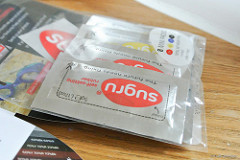
Sugru is a moldable silicone rubber which starts off as a sticky putty which then dries2 into a flexible rubber. It is incredibly useful but very expensive with a relatively short shelf life.3 At roughly $4 per 0.5 gram packet, it is ideal for small fixes around the house, but would be prohibitively expensive for all but the smallest projects.
Oogoo aka DIY Sugru
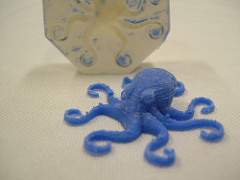
Oogoo is a DIY version of Sugru made from 100% Silicone caulking and corn starch.4 Silicone caulking dries from the outside in and takes about 24 hours. By mixing in corn starch5 the silicone will also dry from the inside out at the same time – in as little as 5 to 10 minutes. Corn starch is easily found in many kitchens and a tube of silicone is very inexpensive (around $4 for a large tube).
I haven’t tried this process yet, but I’ve purchased the silicone and am looking forward to giving it a go. A note of caution – drying silicone is smelly due to the acetic acid released as the silicone cures. It will smell strongly of vinegar while it cures, but should be harmless.
Resins
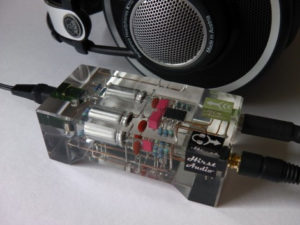
As I mentioned above, some of these ideas have been kicking around in my head for years just waiting for the right inspiration to bring them together. More than four years ago I saw an interesting article on Hackaday about someone who had designed a circuit and then embedded the entire thing within a block of clear resin. There’s so much to love about this process. A resin encased project shouts, “I have made this thing; it is perfect and eternal.”
As I was writing this blog post I began to run into a George R.R. Martin problem – I have so many inspirations, so many ideas, and written so much that I felt I was in danger of never hitting “Publish.”6 Finally I decided to break up the post so that I can share what I have so far. I hope you find it helpful and gives you some ideas of your own – and share them here.
Default Series Title- Though, now that I think about it, this transparency idea could be used as an overlay for any flat project [↩]
- Or cures??? I honestly do not know which is applicable – but I think “cure” is more accurate [↩]
- Let’s just say the cost and shelf life is on par with conductive ink pens. [↩]
- Do not use Silicone II, any quick-curing silicone, or anything less than 100% – this process won’t work [↩]
- and colorants [↩]
- By way of context, this post is about 1,600 words and the draft I began to split up is about 4,000 words and still growing [↩]
Welcome to Radio Shack! Don’t let the door hit you on the way out!

This post could also be entitled, “Customer Service Fail Day.”
TLDR: If you’re looking to build something, don’t even bother going to Radio Shack or Fry’s Electronics.1 Even in the SF Bay Area they won’t carry what you need and if you leave feeling disgusted with their customer service, you’ve gotten off lightly. Buy your parts online from someplace awesome like Adafruit or Sparkfun or someplace else that truly cares about what they do.
TLRA:2 Today I went looking for the last few parts I need to properly finish up my drawing robot. If I was able to locate these parts, my ‘bot would be totally ready to place on a wall and start drawing. Even at the risk of overpaying for a minor part or two or spending way too much time trying to locate a mostly inconsequential part, I wanted to try to finish everything this weekend.
I really should not have bothered. I should have just stayed home in my jammies, surfed the net for the parts I needed, and then waited a few days for them to arrive. If I sound disappointed, it’s probably just because I am. I went looking for some fairly basic parts:
- Eight (8) M3x8 bolts
- Multicolored ribbon cable with at least 4 conductors3
- Male and female connectors4
I would have been perfectly happy to substitute nearly any of these items for something even remotely similar. I would have settled for single color ribbon cable, bolts anywhere from M3x6 – M3x10, and really any kind of male and female connectors that would work. However, all of this is besides the point.
The first stop was a national chain hardware store.5 I honestly wasn’t sure I wanted to visit this store again,6 but I had a $5 coupon and I was pretty sure I would find the metric bolts I needed. On a recent trip to the local hardware store I rooted around their nut/bolt area only to discover that someone or someones had mixed many of the M3 and M4 bolts. It was such a mess that I didn’t want to try them again. I paid a lot more for the eight bolts than I was expecting to, but at least I found the exact number of the exact bolts I needed with no additional hassle. While I was there I also picked up an inexpensive 15′ white extension cord so that my ‘bot could have an extension cord of it’s very own.
The next stop was the local Radio Shack. I haven’t been to a Radio Shack in a really long time – mostly because I’ve had such unsatisfactory experiences there. However, given Radio Shack’s long history of being THE place for Makers to find parts and supplies and their apparent return to their Maker-roots, I was willing to give them another shot. The local Radio Shack is in the middle of a run down strip mall nestled between a Chinese take-out place and something else I don’t recall. I honestly thought the Radio Shack was closed until I got right up to it. As I walked up I held the door open for an older Asian lady. She walked in ahead of me and told the clerk, who was on his cell phone, that she needed to borrow $10. Assuming that these two people knew each other, I just went ahead and looked for where they keep components. Electronic toys up front, phones on the left, tablets and computers on the right, and towards the back under the television blaring some sports game7 I figured I might find some electronics components. The “aisle” was probably only about six feet long and about four feet high. Towards the entrance there were a few Arduinos and books8 on the left, speaker wire on the right, and at the back of the aisle9 on the left was a set of pull out drawers with various bits and bobs that could be used in electronics projects. Except none of it was what I needed. The other employee, a woman, walked over and asked if she could help me. I explained that I needed some ribbon cable and connectors, then I had to explain what they were. Once I had done so she pointed to some colored single-conductor wire. I tried to explain that a ribbon cable had more than one wire in it – and this time she pointed to the same single-conductor wire and then another set of single-color wire of a different color. Seeing that this was completely futile, I asked about connectors. Quite helpfully, she pulled open the drawer marked, “Connectors” and told me that any of them would work. I explained that I needed something I could solder to the wire I was hoping to buy and then be snapped together or pulled apart as needed. She picked up a random baggie of plastic and metal and told me that all the parts were in there. I told her I needed male and female parts. “Yeah, it’s in there.” Since she was pointing to a wire crimp with an eye terminal, I knew that either she had no clue what she was talking about or that she just didn’t give a damn about what she was saying. I honestly cannot understand how that store can justify having two employees at that location at any time, let alone at 2pm on a Sunday afternoon when I was literally the only potential customer around. There cannot possibly be enough consumers of radio controlled cars to keep the lights on in that store. The selection of parts was just abysmal and the service could only have been worse if the staff cared enough to actively insult me. After rooting around in the component drawers for a little, I gave up and walked out. Two employees and neither of them said a single thing as the only potential customer they might see that day walked out the door.
My third stop was to Fry’s Electronics. The parking lot was packed and the store was busy. What I love about this place is the parking lot is ALWAYS packed and the store is ALWAYS busy. It doesn’t matter if I come by first thing in the morning, or in the middle of a weekday, or a Sunday afternoon – it’s nearly impossible to find a parking spot and there are tons of people in there.10 While their staff aren’t always super helpful, I’ve found that about every other employee is actually somewhat knowledgeable about their wares. I walked into the store, past the bargain bin items, took a left at toys, and walked on towards PC components. Since ribbon cables and connectors are the sorts of things one would find inside a PC, I figured this would be the place to start. At the podium stood three young men dressed in black pants and white shirts wearing name tags – I assumed they worked there. The three of them were talking to one another and continued to do so as I stood in front of them. Finally, I said, “Hi!”. The three of them looked at each other and one of them, after several seconds what seemed like a nonverbal game of chicken to see who could go the longest without acknowledging the customer, one of them finally asked how he could help. I explained I needed ribbon cables and connectors. He showed me to wire and speaker wire.11 I explained that ribbon cable involves having multiple strands of conductors attached together to form a sort of “ribbon” of wires that ran together. He must have been spying on me at Radio Shack since he ran through the process of pointing to colored wire, then showing me two different colors of wire. After holding up a thick piece of electrical cord involving two-conductor wires each separately shielded, but attached by plastic, and miming what it would look like with many more wires along side it – but not as thick, he seemed to understand what I was talking about and took me towards some computer ribbon cables and connectors. After an afternoon of searching I felt that I had finally arrived at the right spot. I asked about male and female connectors or perhaps some male and female headers or anything of the sort he looked back over his shoulder towards his comrades and gestured vaguely towards the wall of parts in front of me and suggested I could find what I needed there. I asked him a few more questions while I rooted around for something that could work. Finally he asked if there was anything else I needed. I could tell there was no way this guy was going to help me any further so I thanked him and let him go. I ended up buying some male headers and a set of 4 pin connectors.
Here’s what I’ve learned from my experiences today:
- Radio Shack is a big fat waste of time. I wouldn’t even buy a remote controlled toy car there.
- Fry’s Electronics is a big fat waste of time – unless I am in need of an off-the-shelf computer component and require zero assistance.
- Buying parts online for a better price is absolutely, positively, worth the wait.
- Photo courtesy of Giampaolo Macorig [↩]
- Too long, read anyhow [↩]
- For extending the motor leads [↩]
- So I can swap the motor leads easily [↩]
- The name of the store rhymes with “Orchard Supply Hardware” [↩]
- About two months ago I went there looking for a replacement faucet spray head for our sink. They were out of stock and said it would be in stock in two days. I returned in two days and they didn’t get it in. I was told they would have it in the following day. So, like a moron, I came back. They still did not have it. I went to the local Ace Hardware and they had five of them just sitting on their shelf. DONE. [↩]
- You know, the one with the ball [↩]
- A seemingly grudging token nod towards Makers [↩]
- ALL the way at the end, a whole five feet away [↩]
- Hey, Radio Shack, it’s 2pm, do you know where your customers are? [↩]
- Deep breath now [↩]
